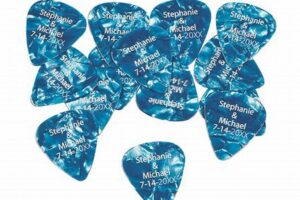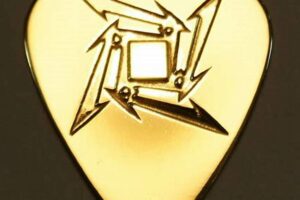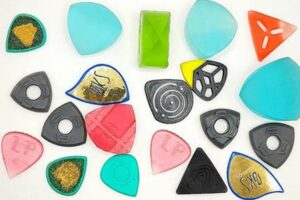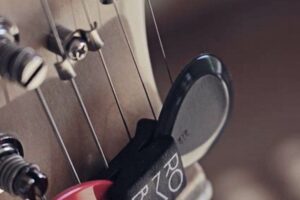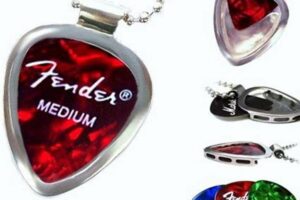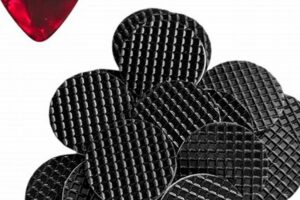What are guitar finger picks?
Guitar finger picks are small, thimble-like devices that are worn on the fingertips to protect them from the strings and to improve grip. They are typically made of metal, plastic, or glass, and come in a variety of shapes and sizes to accommodate different fingers and playing styles.
Why use guitar finger picks?
There are several benefits to using guitar finger picks, including:
- Protection: Finger picks protect the fingertips from the sharp edges of the strings, which can cause pain and discomfort, especially during extended playing sessions.
- Grip: Finger picks provide a better grip on the strings, which can improve accuracy and speed.
- Volume: Finger picks can help to increase the volume of the guitar by projecting the sound of the strings more effectively.
- Tone: Finger picks can also affect the tone of the guitar, by adding brightness and clarity to the sound.
How to choose the right guitar finger picks
There are a few things to consider when choosing guitar finger picks, including the material, the shape, and the size. The best way to find the right picks for you is to experiment with different types and see what works best for your playing style.
Here are some of the most popular types of guitar finger picks:
- Metal finger picks: Metal finger picks are the most durable and provide the best protection for the fingertips. They are also the loudest and brightest sounding.
- Plastic finger picks: Plastic finger picks are less durable than metal picks, but they are more comfortable to wear and provide a warmer, more mellow sound.
- Glass finger picks: Glass finger picks are the most expensive type of finger picks, but they produce the clearest and most articulate sound.
The shape of the finger pick is also important to consider. Some picks have a pointed tip, while others have a rounded tip. The pointed tip picks are better for picking individual strings, while the rounded tip picks are better for strumming chords.
The size of the finger pick is also important. The picks should fit snugly on the fingertips, but they should not be too tight or too loose. If the picks are too tight, they can cut off circulation to the fingers. If the picks are too loose, they will fall off easily.
Once you have chosen the right guitar finger picks, you need to learn how to use them properly. The best way to do this is to practice regularly.
With a little practice, you will be able to use guitar finger picks to improve your playing and protect your fingertips.
1. Material
The material of guitar finger picks is an important consideration because it affects the sound, feel, and durability of the picks. Here is a brief overview of the three most common materials used to make guitar finger picks:
- Metal: Metal finger picks are the most durable and provide the best protection for the fingertips. They are also the loudest and brightest sounding. However, metal finger picks can be uncomfortable to wear for long periods of time and can interfere with the natural feel of the strings.
- Plastic: Plastic finger picks are less durable than metal picks, but they are more comfortable to wear and provide a warmer, more mellow sound. Plastic finger picks are also less expensive than metal picks, making them a good option for beginners.
- Glass: Glass finger picks are the most expensive type of finger picks, but they produce the clearest and most articulate sound. Glass finger picks are also very durable, but they can be difficult to find and can break easily if they are dropped.
Ultimately, the best material for guitar finger picks depends on the individual player’s preferences. Some players prefer the durability and sound of metal picks, while others prefer the comfort and feel of plastic picks. Glass picks offer the best sound quality, but they are more expensive and difficult to find.
Here is a table summarizing the key differences between metal, plastic, and glass finger picks:
| Material | Durability | Comfort | Sound | Price ||—|—|—|—|—|| Metal | High | Low | Bright, loud | High || Plastic | Low | High | Warm, mellow | Low || Glass | High | Medium | Clear, articulate | High |
2. Shape
The shape of a guitar finger pick is an important consideration because it affects the way the pick interacts with the strings. Pointed tips are better for picking individual strings, while rounded tips are better for strumming chords. The shape of the pick also affects the tone of the guitar. Pointed tips produce a brighter sound, while rounded tips produce a warmer sound.
- Pointed tips are best for picking individual strings. They are also good for playing lead guitar and fingerstyle guitar.
- Rounded tips are best for strumming chords. They are also good for playing rhythm guitar and bass guitar.
- The shape of the pick also affects the tone of the guitar. Pointed tips produce a brighter sound, while rounded tips produce a warmer sound.
- The size of the pick also affects the tone of the guitar. Larger picks produce a louder sound, while smaller picks produce a softer sound.
Ultimately, the best shape and size of guitar finger pick for you depends on your individual playing style and preferences. Experiment with different picks to find the ones that work best for you.
3. Size
The size of a guitar finger pick is an important consideration because it affects the comfort and playability of the pick. A pick that is too small will be difficult to hold onto and control, while a pick that is too large will be uncomfortable to wear and can interfere with the natural movement of the fingers.
To choose the right size finger pick, measure the width of your fingertips from the tip to the first knuckle. The width of the pick should be slightly wider than the width of your fingertips. If you are between sizes, it is better to choose the smaller size.
Here is a table summarizing the key considerations for choosing the right size guitar finger pick:
| Factor | Considerations ||—|—|| Finger size | Measure the width of your fingertips from the tip to the first knuckle. || Pick width | The width of the pick should be slightly wider than the width of your fingertips. || Comfort | The pick should be comfortable to wear and should not inte
rfere with the natural movement of the fingers. |
By following these guidelines, you can choose the right size guitar finger pick for your needs and improve your playing comfort and accuracy.
4. Fit
The fit of a guitar finger pick is crucial for both comfort and playability. A pick that is too tight can cut off circulation to the finger, causing pain and discomfort. A pick that is too loose can fall off easily, which can be frustrating and disruptive during playing.
The ideal fit for a guitar finger pick is snug but not too tight. The pick should stay securely on the finger without causing any discomfort. It should also allow the finger to move freely and naturally.
There are several factors to consider when choosing the right size and fit of guitar finger picks. These include the size of the fingers, the shape of the picks, and the material of the picks.
Here is a table summarizing the key considerations for choosing the right fit for guitar finger picks:
| Factor | Considerations ||—|—|| Finger size | Measure the width of your fingertips from the tip to the first knuckle. || Pick size | The size of the pick should be slightly wider than the width of your fingertips. || Pick shape | The shape of the pick can also affect the fit. Pointed tips are better for picking individual strings, while rounded tips are better for strumming chords. || Pick material | The material of the pick can also affect the fit. Metal picks are more durable, but they can be less comfortable to wear than plastic or glass picks. |
By following these guidelines, you can choose the right fit for guitar finger picks and improve your playing comfort and accuracy.
5. Protection
When playing guitar, the strings can be sharp and abrasive on the fingers, especially when playing for extended periods of time. This can lead to pain, discomfort, and even blisters. Finger picks provide a barrier between the strings and the fingers, protecting them from these sharp edges.
- Comfort: Finger picks can make playing guitar more comfortable, especially during long playing sessions. By protecting the fingers from the strings, finger picks can help to reduce pain and discomfort, allowing guitarists to play for longer periods of time without experiencing discomfort.
- Protection from injury: Finger picks can also help to protect the fingers from injury. The sharp edges of the strings can sometimes cause cuts or other injuries to the fingers. Finger picks can help to prevent these injuries by providing a barrier between the strings and the fingers.
- Improved playing technique: Finger picks can also help to improve playing technique. By providing a more stable surface for picking the strings, finger picks can help guitarists to play with greater accuracy and control. This can lead to better overall playing technique and improved sound quality.
Overall, finger picks are an essential tool for guitarists of all levels. They can help to protect the fingers from the sharp edges of the strings, improve playing comfort, and improve playing technique. As a result, finger picks can help guitarists to play better and enjoy playing guitar more.
6. Grip
Finger picks can improve grip on the strings, which can lead to improved accuracy and speed. This is because finger picks provide a more stable surface for picking the strings, which allows guitarists to control the strings more precisely. As a result, guitarists can play with greater accuracy and speed.
- Enhanced precision: Finger picks provide a more stable surface for picking the strings, which allows guitarists to control the strings more precisely. This enhanced precision leads to improved accuracy when playing notes and chords.
- Increased speed: The improved grip provided by finger picks also allows guitarists to play faster. This is because guitarists can pick the strings more quickly and easily with finger picks, which leads to increased speed when playing.
- Reduced fatigue: Finger picks can also help to reduce fatigue when playing guitar. This is because finger picks distribute the pressure of picking the strings over a larger surface area, which reduces the strain on the fingers. As a result, guitarists can play for longer periods of time without experiencing fatigue.
Overall, finger picks can improve grip on the strings, which can lead to improved accuracy, speed, and reduced fatigue. As a result, finger picks are an essential tool for guitarists of all levels who want to improve their playing.
7. Volume
Finger picks increase the volume of the guitar by projecting the sound of the strings more effectively. This is because finger picks provide a larger surface area for the strings to vibrate against, which results in a louder sound. In addition, finger picks help to focus the sound of the strings, which makes it more directional and easier to hear.
The increased volume provided by finger picks can be beneficial in a variety of situations. For example, finger picks can be used to:
- Cut through a loud mix on stage
- Project the sound of the guitar in a large room
- Create a more powerful and dynamic sound
Overall, finger picks are an essential tool for any guitarist who wants to increase the volume of their instrument.
Here is a table summarizing the key points about the connection between finger picks and volume:
| Feature | Effect on Volume |
|---|---|
| Larger surface area | Increases the volume of the sound |
| Focuses the sound of the strings | Makes the sound more directional and easier to hear |
8. Tone
Finger picks have a significant impact on the tone of the guitar. This is because the material, shape, and size of the pick all affect the way that the pick interacts with the strings.
In general, metal finger picks produce a brighter sound than plastic or glass picks. This is because metal is a harder material and it creates more high-frequency overtones when it strikes the strings. Plastic and glass picks, on the other hand, produce a warmer sound with less high-frequency overtones.
The shape of the pick also affects the tone. Pointed picks produce a brighter sound than rounded picks. This is because pointed picks have a smaller surface area that makes contact with the strings, which results in less damping of the high frequencies. Rounded picks, on the other hand, have a larger surface area that makes contact with the strings, which results in more damping of the high frequencies.
The size of the pick also affects the tone. Larger picks produce a louder sound with more low-frequency overtones. This is becau
se larger picks have more mass and they move more air when they strike the strings. Smaller picks, on the other hand, produce a quieter sound with less low-frequency overtones.
The choice of finger pick is a personal one and depends on the desired sound. However, by understanding the relationship between the material, shape, and size of the pick and the tone of the guitar, guitarists can choose the right pick to achieve the sound they want.
Here is a table summarizing the key points about the connection between finger picks and tone:
| Feature | Effect on Tone |
|---|---|
| Material | Metal picks produce a brighter sound than plastic or glass picks. |
| Shape | Pointed picks produce a brighter sound than rounded picks. |
| Size | Larger picks produce a louder sound with more low-frequency overtones. |
9. Style
The style of finger picks can have a significant impact on the sound and feel of the guitar. Different materials, shapes, and sizes of finger picks can produce different tones and volumes. For example, metal finger picks produce a brighter sound than plastic or glass picks, while pointed picks produce a brighter sound than rounded picks. The size of the pick can also affect the tone, with larger picks producing a louder sound with more low-frequency overtones.In addition to the sound, the style of finger picks can also affect the feel of the guitar. Some picks are more comfortable to wear than others, and some picks can make it easier to play certain types of music. For example, finger picks with a beveled edge can make it easier to play lead guitar, while finger picks with a rounded edge can make it easier to play rhythm guitar.Ultimately, the best way to choose the right style of finger picks is to experiment with different types and see what works best for you. There is no right or wrong answer, and the best pick for you will depend on your individual playing style and preferences.
Here are some of the most popular styles of finger picks:
- Metal finger picks: Metal finger picks are the most durable and provide the best protection for the fingertips. They are also the loudest and brightest sounding.
- Plastic finger picks: Plastic finger picks are less durable than metal picks, but they are more comfortable to wear and provide a warmer, more mellow sound.
- Glass finger picks: Glass finger picks are the most expensive type of finger picks, but they produce the clearest and most articulate sound.
- Thumb picks: Thumb picks are worn on the thumb and are used for playing bass lines and other low notes. They come in a variety of styles, including metal, plastic, and glass.
- Finger picks with a beveled edge: Finger picks with a beveled edge are designed to make it easier to play lead guitar. They have a slanted edge that allows the pick to glide over the strings more easily.
- Finger picks with a rounded edge: Finger picks with a rounded edge are designed to make it easier to play rhythm guitar. They have a rounded edge that provides a more comfortable grip.
By understanding the different styles of finger picks available, you can choose the right pick for your playing style and preferences.
| Style | Sound | Feel |
|---|---|---|
| Metal finger picks | Bright, loud | Durable, protective |
| Plastic finger picks | Warm, mellow | Comfortable, less durable |
| Glass finger picks | Clear, articulate | Expensive, fragile |
| Thumb picks | Low notes, bass lines | Variety of styles |
| Finger picks with a beveled edge | Lead guitar | Slanted edge for easier playing |
| Finger picks with a rounded edge | Rhythm guitar | Rounded edge for more comfortable grip |
Frequently Asked Questions about Guitar Finger Picks
Guitar finger picks are small, thimble-like devices that are worn on the fingertips to protect them from the strings and to improve grip. They are typically made of metal, plastic, or glass, and come in a variety of shapes and sizes to accommodate different fingers and playing styles.
Here are some of the most frequently asked questions about guitar finger picks:
Question 1: What are the benefits of using guitar finger picks?
There are several benefits to using guitar finger picks, including:
- Protection: Finger picks protect the fingertips from the sharp edges of the strings, which can cause pain and discomfort, especially during extended playing sessions.
- Grip: Finger picks provide a better grip on the strings, which can improve accuracy and speed.
- Volume: Finger picks can help to increase the volume of the guitar by projecting the sound of the strings more effectively.
- Tone: Finger picks can also affect the tone of the guitar, by adding brightness and clarity to the sound.
Question 2: What are the different types of guitar finger picks?
There are three main types of guitar finger picks: metal, plastic, and glass. Metal finger picks are the most durable and provide the best protection for the fingertips. They are also the loudest and brightest sounding. Plastic finger picks are less durable than metal picks, but they are more comfortable to wear and provide a warmer, more mellow sound. Glass finger picks are the most expensive type of finger picks, but they produce the clearest and most articulate sound.
Question 3: How do I choose the right guitar finger picks?
The best way to choose the right guitar finger picks is to experiment with different types and see what works best for you. However, there are a few things to keep in mind when choosing finger picks, including the material, the shape, the size, and the fit.
Question 4: How do I use guitar finger picks?
Once you have chosen the right guitar finger picks, you need to learn how to use them properly. The best way to do this is to practice regularly. With a little practice, you will be able to use guitar finger picks to improve your playing and protect your fingertips.
Question 5: What are some tips for using guitar finger picks?
Here are a few tips for using guitar finger picks:
- Start by using finger picks on just one or two fingers.
- Practice regularly to get used to the feel of the picks.
- Experiment with different picking techniques to find what works best for you.
- Don’t be afraid to make mistakes. Everyone makes mistakes when they are first learning to use finger picks.
Question 6: What are some common mistakes that people make when using guitar finger picks?
Some common mistakes that people make when using guitar finger picks include:
- Using the wrong size finger picks.
- Using the picks incorrectly.
- Not practicing regularly.
- Getting discouraged.
By avoiding these mistakes, you can quickly learn to use guitar finger picks to improve your playing.
Summary
Guitar finger picks are a valuable tool for any guitarist. They can help to protect the fingertips, improve grip, increase volume, and enhance tone. By choosing the right finger picks and
using them properly, you can improve your playing and enjoy playing guitar more.
Transition to the next article section
Now that you know more about guitar finger picks, you can start experimenting with different types and see what works best for you. With a little practice, you will be able to use finger picks to improve your playing and protect your fingertips.
Guitar Finger Pick Tips
Guitar finger picks are a valuable tool for any guitarist. They can help to protect the fingertips, improve grip, increase volume, and enhance tone. Here are some tips to help you get the most out of your finger picks:
Tip 1: Choose the right finger picks.
The best finger picks for you will depend on your playing style and preferences. Metal finger picks are the most durable and provide the best protection for the fingertips. They are also the loudest and brightest sounding. Plastic finger picks are less durable than metal picks, but they are more comfortable to wear and provide a warmer, more mellow sound. Glass finger picks are the most expensive type of finger picks, but they produce the clearest and most articulate sound.
Tip 2: Use the right size finger picks.
Finger picks should fit snugly on the fingertips, but they should not be too tight or too loose. If the picks are too tight, they can cut off circulation to the fingers. If the picks are too loose, they will fall off easily. To choose the right size finger picks, measure the width of your fingertips from the tip to the first knuckle. The width of the pick should be slightly wider than the width of your fingertips.
Tip 3: Use the picks correctly.
There are two main ways to use finger picks: the pinch grip and the thumb grip. The pinch grip is the most common way to use finger picks. To use the pinch grip, place the pick between your thumb and forefinger and pinch it together. The thumb grip is less common, but it can be more comfortable for some players. To use the thumb grip, place the pick on your thumb and use your other fingers to support it.
Tip 4: Practice regularly.
The best way to get good at using finger picks is to practice regularly. Start by using finger picks on just one or two fingers. Once you get comfortable with using the picks on one or two fingers, you can start using them on all of your fingers. Practice picking individual strings, chords, and scales. With a little practice, you will be able to use finger picks to improve your playing and protect your fingertips.
Tip 5: Don’t be afraid to make mistakes.
Everyone makes mistakes when they are first learning to use finger picks. Don’t get discouraged if you make a mistake. Just keep practicing and you will eventually get the hang of it. By following these tips, you can get the most out of your guitar finger picks and improve your playing.
Summary
Guitar finger picks are a valuable tool for any guitarist. They can help to protect the fingertips, improve grip, increase volume, and enhance tone. By choosing the right finger picks, using them correctly, and practicing regularly, you can improve your playing and enjoy playing guitar more.
Transition to the article’s conclusion
Now that you know more about guitar finger picks and how to use them, you can start experimenting with different types and see what works best for you. With a little practice, you will be able to use finger picks to improve your playing and protect your fingertips.
Conclusion
Guitar finger picks are an essential tool for any guitarist. They can help to protect the fingertips from the sharp edges of the strings, improve grip, increase volume, and enhance tone. By choosing the right finger picks and using them correctly, you can improve your playing and enjoy playing guitar more.
If you are new to using finger picks, don’t be afraid to experiment with different types and see what works best for you. With a little practice, you will be able to use finger picks to improve your playing and protect your fingertips. Guitar finger picks are a valuable tool that can help you to take your playing to the next level.


